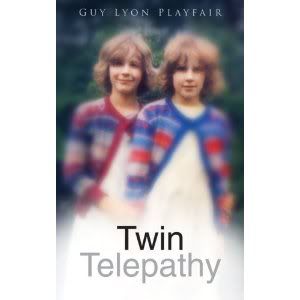Nor is Gemma the first twin who may have saved a life. I know of at least three other examples, one of which I investigated at first-hand. This would suggest that if telepathy can save lives, the scientific community should take rather more interest in it than it yet has. As
The Times (25 March) put it: ‘Something about the “telepathic” bond between twins seems to transcend even scientific reason’ (note the inverted commas guarding the taboo T word). Yet the usual reaction of scientists to reports of incidents such as the one mentioned above is to mutter about ‘thought concordance’, ‘genetic underpinning’ or that old favourite, ‘coincidence’ and change the subject as soon as possible.The twin bond also seems to transcend scientific curiosity. It must be one of the most under-researched areas in all of science. Even parapsychologists have a dismal record – it doesn’t take long to read everything they have written about it in the specialist journals. They have generally preferred tedious laboratory card-guessing experiments, at which twins tend to be no better than anybody else, to venturing into the field and identifying the conditions under which telepathy occurs spontaneously.
What they would find there is that telepathy tends to work best when it is needed, and when sender and receiver are strongly bonded, as with mothers and babies, dogs and their owners, and those with the strongest bond of all – twins. Twin telepathy is an example of what Margaret Mead called a ‘recurrent irregularity’, and if the same irregularity recurs often enough it becomes increasingly probable that it is a genuine phenomenon, as many twins already ‘just know’.
Twin telepathy has been recurring regularly at least since 1844, when Alexandre Dumas made it a prominent feature of his novel
The Corsican Brothers. This is generally thought to have been based on a real-life pair since he describes so accurately the kinds of experience that twins pick up from each other – almost invariably some kind of bad news such as pain, sickness, or death as in the case of his two heroes, one of whom falls off his horse, under the impression that he has been shot, at the moment his brother is shot dead in a duel hundreds of miles away. I have been given an eye-witness account of the equally dramatic reaction of a twin whose brother was murdered. He too ‘just knew’.
Yet for all its recurrence, the inexplicability of telepathy has led science to avoid it like some mediaeval plague or even to pontificate that it doesn’t exist because it can’t. Dr Nancy Segal, a former co-director of the massive twin research programme at the University of Minnesota has decreed that ‘the bottom line is that I feel there’s no evidence for ESP in twins’. She devotes just ten lines of her 432-page book
Entwined Lives to the subject of extrasensory perception (a term no longer used by most psi researchers), stating that ‘I do not question the occurrence of twins’ “ESP-like” behaviour. I do wonder why some people endorse ESP in the face of more compelling data from twin studies.’ (Such as?). Could it not be that an experience that is ‘ESP-like’ might actually be what it looks like?
When confronted with some very compelling data recorded on a polygraph in the 2004 Discovery channel programme
Miracle Hunters, Dr Segal commented, looking rather uncomfortable, ‘Well, I think there’s something there. I just don’t think it’s telepathy.’ Another clip of polygrapher Jeremy Barrett’s chart pen jumping all over the place while the twin in another room was given mild shocks made her look even more uneasy, as if ominous cracks were appearing in the walls of her belief system. ‘I think it’s a kind of intriguing finding’, she admitted. ‘Am I going to call it telepathy? I think at this point I’m not.’
Jeremy Barrett who unlike Dr Segal can base his opinion on research rather than prejudice is going to call it just that. After doing tests with nine sets of twins (four of them shown on television) he told
Fortean Times (June 2003): ‘What we have done with the polygraph instrument is measure things happening which should not be happening. There is absolutely no doubt at all in my mind that there is a communication taking place between these pairs of people which is beyond any explanation other than telepathy.’ These were not scientifically controlled experiments, I should add, but should be seen as informal pilot tests that gave highly suggestive results that call for replication under tighter conditions.
Scientists who find something intriguing should examine it further, although in this case they generally haven’t. So it is good to be able to report at long last something of a potential breakthrough in twin telepathy research. In 2004 the Department of Twin Research and Genetic Epidemiology at King’s College London sent a questionnaire to the 10,000 twins on its books that included a question never asked before, to my knowledge, by a scientific body: ‘Do you have the ability to know what is happening to your co-twin when you are not there?’ More than half (54%) said yes or maybe, only 46% said no. What was particularly intriguing about these results, apart from the fact that there are some 5,000 twins out there who think they have or might have experienced telepathy, was the fact that nearly twice as many identical as fraternal (non-identical) ones said yes.
This only became widely known when it was mentioned in the Times article cited above, and I am glad to be able to report that the King’s group is considering a proposal for a telepathy research programme headed by a professor of psychology and one of our leading psi researchers.
Let us hope that science will one day get around at last to confirming what many twins already ‘just know’, as concisely summed up by Californian supermodel Barbi sisters (
Sunday Telegraph Magazine, 9 June, 2002):Sia Barbi: ‘We have that twin thing going on. Wherever we are in the world, we kind of know what the other one’s doing.’
Shane Barbi: ‘That’s right. It’s instinctive. It’s a twin thing.’


























